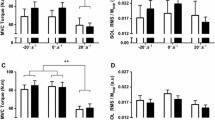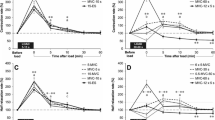Abstract
Background and aims: This study examined the effect of recreational physical activity on the contractile properties of skeletal muscles in middle- aged vs young women. Methods: A total 74 young (20–29-year-old) and middle-aged (45–54-year-old) women participated. The subjects were distributed into four groups: 1) young recreationally physically active (RPA) (n=19), 2) young recreationally physically non-active (RPN) (n=21), 3) middle-aged RPA (n=23) and 4) middle-aged RPN (n=16). RPA women exercised regularly in groups of recreational gymnastics 2–3 times per week. Isometric twitch of the plantarflexor muscles was evoked by supramaximal electrical stimulation of the tibial nerve in resting and post-activation potentiation state. Results: A greater resting twitch maximal rate of force development (RFD), and potentiated twitch peak force (PF) and maximal rate of relaxation (RR) were observed in the young RPA women compared with the two middle-aged women groups. In young RPN women, these characteristics were greater than in the middle-aged RPN women, whereas they did not differ significantly when compared with the middle- aged RPA women. A shorter resting and potentiated twitch contraction time, and a greater potentiated twitch maximal RFD were found in the young compared with the middle-aged groups. There were no significant differences in twitch characteristics between RPA and RPN women of similar age. Conclusions: The recreational gymnastic type of physical activity did not have a marked effect on twitch contractile properties in young and middle-aged women. A reduced speed of isometric twitch contraction was found in middle-aged women, which was more pronounced in the post-activation potentiation state.
Similar content being viewed by others
References
McDonagh MJN, White MJ, Davies CTM. Different effects of aging on the mechanical properties of human arm and leg muscles. Gerontology 1984; 30: 49–54.
Vandervoort AA, McComas AJ. Contractile changes in opposing muscles of the human ankle joint with aging. J Appl Physiol 1986; 61: 361–7.
Pääsuke M, Ereline J, Gapeyeva H, Sirkel S, Sander P. Age-related differences in twitch contractile properties of plantarflexor muscles in women. Acta Physiol Scand 2000; 170: 51–7.
Pääsuke M, Ereline J, Gapeyeva H, Sander P, Sirkel S. Twitch potentiation capacity of plantarflexor muscles in women with increasing age. Biol Sport 2002; 19: 213–23.
Vandervoort AA. Aging of the human neuromuscular system. Muscle Nerve 2002; 25: 17–25.
Stein RB, Parmiggiani F. Nonlinear summation of contractions in cat muscles. I. Early depression. J Gen Physiol 1981; 78: 277–93.
Docherty TJ, Vandervoort AA, Taylor AW, Brown WF. Effects of motor unit losses on strength in older men and women. J Appl Physiol 1993; 74: 868–74.
Klitgaard H, Ausoni S, Damiani E. Sarcoplasmic reticulum of human skeletal muscle: age-related changes and effect of training. Acta Physiol Scand 1989; 137: 23–31.
Booth FM, Weeden SH, Tseng BS. Effect of aging on human skeletal muscle and motor function. Med Sci Sports Exerc 1994; 26: 556–60.
Rantanen T, Era P, Heikkinen E. Physical activity and the changes in maximal isometric strength in men and women from the age of 75 to 80 years. J Am Geriatr Soc 1997; 45: 1534–5.
Roubenoff R, Hughes VA. Sarcopenia: current concepts. J Gerontol A Biol Sci Med Sci 2000; 55: M716–M724.
Rice CL, Cunningham DA, Paterson DH, Dickinson JR. Strength training alters contractile properties of the triceps brachii in men aged 65–78 years. Eur J Appl Physiol 1993; 66: 275–80.
Hicks AL, McCartney N. Gender differences in isometric contractile properties and fatigability in elderly human muscle. Can J Appl Physiol 1996; 21: 441–54.
Welsh L, Rutherford OM. Effects of isometric strength training on quadriceps muscle properties in over 55 year olds. Eur J Appl Physiol 1996; 72: 219–23.
Kirkendall DT, Garret WE. The effects of aging and training on skeletal muscle. Am J Sport Med 1998; 26: 598–602.
Morse CI, Thom JM, Mian OS, Muirhead A, Birch KM, Narici MV. Muscle strength, volume and activation following 12-month resistance training in 70-year-old males. Eur J Appl Physiol 2005; 95: 197–204.
Vandervoort AA, Hayes KL, Belanger AY. Strength and endurance of skeletal muscle in the elderly. Physiother Can 1986; 38: 167–73.
Hamada T, Sale DG, MacDougall JD, Tarnopolsky MA. Postac-tivation potentiation, fiber type, and twitch contraction time in human knee extensor muscles. J Appl Physiol 2000; 88: 2131–7.
Grange RW, Vandenboom R, Houston ME. Physiological significance of myosin phosphorylation in skeletal muscle. Can J App Physiol 1993; 18: 229–42.
Sweeny HL, Boman BF, Stull JT. Myosin light chain phospho-rylation in vertebrate striated muscle: regulation and function. Am J Cell Physiol 1993; 264: C1085–95.
Petrella RJ, Cunningham DA, Vandervoort AA, Paterson DH. Comparison of twitch potentiation in the gastrocnemius of young and elderly men. Eur J Appl Physiol 1989; 58: 395–9.
Sale DG, Quinlan J, Marsh E, McComas AJ, Belanger AY. Influence of joint position on ankle plantarflexion in humans. J Appl Physiol 1982; 5: 1632–42.
Frontera WR, Hughes VA, Lutz KJ, Evans WJ. A cross-sectional study of muscle strength and mass in 45- to 78-yr-old men and women. J Appl Physiol 1991; 71: 644–50.
Kent-Braun JA, Ng AV. Specific strength and voluntary muscle activation in young and elderly women and men. J Appl Physiol 1999; 87: 22–9.
Häkkinen K, Pakarinen A. Muscle strength and serum testosterone, cortisol and SHBG concentrations in middle-aged and elderly men and women. Acta Physiol Scand 1993; 148: 199–207.
Mälkiä E, Impivaara O, Heliövaara M, Maatela J. The physical activity of healthy and chronically ill adults in Finland at work, at leisure and during commuting. Scand J Med Sci Sport 1994; 4: 82–7.
Samson MM, Meeuwsen IB, Crowe A, Dessens JA, Duursma SA, Verhaar HJ. Relationships between physical performance measures, age, height and body weight in healthy adults. Age Aging 2000; 29: 235–42.
Bohannon RW. Nature of age-related changes in muscle strength of the extremities of women. Percept Mot Skills 1996; 83: 1155–60.
Klug GA, Botterman BR, Stull JT. The effect of low frequency stimulation on myosin light chain phosphorylation in skeletal muscle. J Biol Chem 1982; 257: 4688–90.
Houston ME, Green H-J, Stull JT. Myosin light chain phospho-rylation and isometric twitch potentiation in intact human muscle. Pflüg Arch 1985; 403: 348–52.
Persechini A, Stull JT, Cooke R. The effect of myosin phos-phorylation on the contractile properties of skinned rabbit skeletal muscle fibers. J Biol Chem 1985; 260: 7951–54.
MacIntosh BR, Gardiner PF. Posttetanic potentiation and skeletal muscle fatigue: interactions with caffeine. Can J Physiol Pharmacol 1987; 65: 260–8.
Vandervoort AA, Hayes KC. Plantarflexor muscle function in young and elderly women. Eur J Appl Physiol 1989; 58: 389–94.
Lewis DM, Al-Amood WS, Rosendorff C. Stimulation of dener-vated muscle: what do isometric and isotonic recordings tell us? In Nix WA, Vrbova G, Eds. Electrical Stimulation and Neuro-muscular Disorders. Berlin: Springer-Verlag, 1986; 101–13.
Andersen JL. Muscle fiber type adaptation in the elderly human muscle. Scand J Med Sci Sports 2003; 13: 40–7.
Lexell J, Downham D. What is the effect of aging on type 2 muscle fibers? J Neurol Sci 1992; 107: 250–1.
Westerblad H, Lännegren J, Allen DG. Slowed relaxation in fatigued skeletal muscle fiber of Xenopus and mouse: Contribution of [Ca2+] and cross-bridges. J Gen Physiol 1997; 109: 385–99.
Author information
Authors and Affiliations
Corresponding author
Rights and permissions
About this article
Cite this article
Kuu, S., Gapeyeva, H., Ereline, J. et al. Twitch contractile properties of plantarflexor muscles in young and middle-aged recreationally physically active and non-active women. Aging Clin Exp Res 19, 48–54 (2007). https://doi.org/10.1007/BF03325210
Received:
Accepted:
Published:
Issue Date:
DOI: https://doi.org/10.1007/BF03325210




